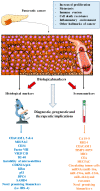Clinical Applications of Classical and Novel Biological Markers of Pancreatic Cancer
- PMID: 35454771
- PMCID: PMC9029823
- DOI: 10.3390/cancers14081866
Clinical Applications of Classical and Novel Biological Markers of Pancreatic Cancer
Abstract
The incidence and prevalence of pancreatic adenocarcinoma have increased in recent years. Pancreatic cancer is the seventh leading cause of cancer death, but it is projected to become the second leading cause of cancer-related mortality by 2040. Most patients are diagnosed in an advanced stage of the disease, with very limited 5-year survival. The discovery of different tissue markers has elucidated the underlying pathophysiology of pancreatic adenocarcinoma and allowed stratification of patient risk at different stages and assessment of tumour recurrence. Due to the invasive capacity of this tumour and the absence of screening markers, new immunohistochemical and serological markers may be used as prognostic markers for recurrence and in the study of possible new therapeutic targets because the survival of these patients is low in most cases. The present article reviews the currently used main histopathological and serological markers and discusses the main characteristics of markers under development.
Keywords: histological markers; pancreatic adenocarcinoma; pancreatic immunohistochemistry; serological markers.
Conflict of interest statement
The authors declare no conflict of interest.
Figures

References
-
- Pourshams A., Sepanlou S.G., Ikuta K.S., Bisignano C., Safiri S., Roshandel G., Sharif M., Khatibian M., Fitzmaurice C., Nixon M.R., et al. The global, regional, and national burden of pancreatic cancer and its attributable risk factors in 195 countries and territories, 1990–2017: A systematic analysis for the Global Burden of Disease Study 2017. Lancet Gastroenterol. Hepatol. 2019;4:934–947. doi: 10.1016/S2468-1253(19)30347-4. - DOI - PMC - PubMed
Publication types
Grants and funding
LinkOut - more resources
Full Text Sources

